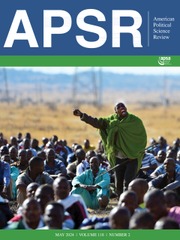Crossref Citations
This article has been cited by the following publications. This list is generated based on data provided by
Crossref.
Prewitt, Kenneth
2012.
When You Have a Hammer ….
Du Bois Review: Social Science Research on Race,
Vol. 9,
Issue. 2,
p.
281.
Fausto-Sterling, Anne
2012.
Not Your Grandma’s Genetics.
Psychology of Women Quarterly,
Vol. 36,
Issue. 4,
p.
411.
Hatemi, Peter K.
and
McDermott, Rose
2012.
The genetics of politics: discovery, challenges, and progress.
Trends in Genetics,
Vol. 28,
Issue. 10,
p.
525.
De Neve, Jan-Emmanuel
Mikhaylov, Slava
Dawes, Christopher T.
Christakis, Nicholas A.
and
Fowler, James H.
2012.
Born to Lead? A Twin Design and Genetic Association Study of Leadership Role Occupancy.
SSRN Electronic Journal,
Charney, Evan
2012.
Behavior genetics and postgenomics.
Behavioral and Brain Sciences,
Vol. 35,
Issue. 5,
p.
331.
Charney, Evan
2012.
Humans, fruit flies, and automatons.
Behavioral and Brain Sciences,
Vol. 35,
Issue. 5,
p.
381.
Spolaore, Enrico
and
Wacziarg, Romain
2013.
How Deep Are the Roots of Economic Development?.
Journal of Economic Literature,
Vol. 51,
Issue. 2,
p.
325.
Marks, Jonathan
2013.
The Nature/Culture of Genetic Facts.
Annual Review of Anthropology,
Vol. 42,
Issue. 1,
p.
247.
Verhulst, Brad
and
Hatemi, Peter K.
2013.
Gene-Environment Interplay in Twin Models.
Political Analysis,
Vol. 21,
Issue. 3,
p.
368.
FOWLER, JAMES H.
and
DAWES, CHRISTOPHER T.
2013.
In Defense of Genopolitics.
American Political Science Review,
Vol. 107,
Issue. 2,
p.
362.
DEPPE, KRISTEN DIANE
STOLTENBERG, SCOTT F.
SMITH, KEVIN B.
and
HIBBING, JOHN R.
2013.
Candidate Genes and Voter Turnout: Further Evidence on the Role of 5-HTTLPR.
American Political Science Review,
Vol. 107,
Issue. 2,
p.
375.
Boardman, Jason D.
Daw, Jonathan
and
Freese, Jeremy
2013.
Defining the Environment in Gene–Environment Research: Lessons From Social Epidemiology.
American Journal of Public Health,
Vol. 103,
Issue. S1,
p.
S64.
Barnes, J.C.
TenEyck, Michael
Boutwell, Brian B.
and
Beaver, Kevin M.
2013.
Indicators of domestic/intimate partner violence are structured by genetic and nonshared environmental influences.
Journal of Psychiatric Research,
Vol. 47,
Issue. 3,
p.
371.
Shultziner, Doron
2013.
Genes and Politics: A New Explanation and Evaluation of Twin Study Results and Association Studies in Political Science.
Political Analysis,
Vol. 21,
Issue. 3,
p.
350.
Charney, Evan
2013.
Politics and Biology.
Perspectives on Politics,
Vol. 11,
Issue. 2,
p.
558.
CHARNEY, EVAN
and
ENGLISH, WILLIAM
2013.
Genopolitics and the Science of Genetics.
American Political Science Review,
Vol. 107,
Issue. 2,
p.
382.
Hatemi, Peter K.
2013.
The Influence of Major Life Events on Economic Attitudes in a World of Gene‐Environment Interplay.
American Journal of Political Science,
Vol. 57,
Issue. 4,
p.
987.
Barnes, J. C.
Beaver, Kevin M.
Boutwell, Brian B.
and
Homberg, Judith
2013.
A Functional Polymorphism in a Serotonin Transporter Gene (5-HTTLPR) Interacts with 9/11 to Predict Gun-Carrying Behavior.
PLoS ONE,
Vol. 8,
Issue. 8,
p.
e70807.
Joseph, Jay
2013.
Embodiment and Epigenesis: Theoretical and Methodological Issues in Understanding the Role of Biology within the Relational Developmental System - Part B: Ontogenetic Dimensions.
Vol. 45,
Issue. ,
p.
93.
Hibbing, John R.
2013.
Ten Misconceptions Concerning Neurobiology and Politics.
Perspectives on Politics,
Vol. 11,
Issue. 2,
p.
475.





Comments
No Comments have been published for this article.